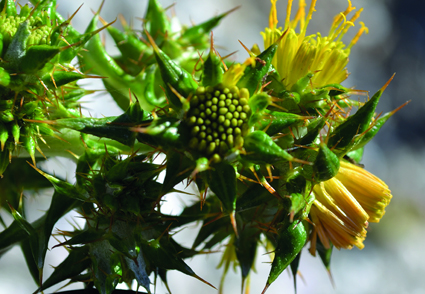Abstract
As part of a taxonomic reassessment of species that were classified in Berkheya series Rigidae in the most recent monograph of Berkheya, the type material for Berkheya rigida and its putative heterotypic synonyms is reassessed. The original material for the basionym, Stobaea rigida, is heterospecific. Therefore, a second-step lectotype is designated consistent with predominant usage of the name Berkheya rigida. The name Apuleia rigida and its replacement name Stobaea gaertneri apply to a conspicuously radiate species and are excluded from the synonymy of Berkheya rigida. The morphological variability of Berkheya rigida is discussed.
References
- Catalogue of Life. (2023) Berkheya rigida. Catalogue of Life Checklist. Available from: https://www.catalogueoflife.org/data/taxon/5WJSM (accessed: 21 October 2023).
- Candolle, A.P. de. (1838 [dated 1837]) Prodromus systematis naturalis regni vegetabilis, sive enumeratio contracta ordinum, generum, specierumque plantarum hucusque cognitarum, juxta methodi naturalis normas digesta 6. Treuttel & Würtz, Paris, 687 pp. https://doi.org/10.5962/bhl.title.286
- Deleuze, [J.P.F.]. (1804) Some account of the life and writings of the late Dr. Gaertner. Annals of Botany (König & Sims) 1: 73–99.
- Ehrhart, F. (1784) Berkheya, eine Pflanzengattung. Neues Magazin für Ärzte 6: 303–307.
- Ewart, A.J., White, J. & Rees, B. (1909) Contributions to the flora of Australia, no. 11. Proceedings of the Royal Society of Victoria, new series 22: 6–23. [https://www.biodiversitylibrary.org/page/8509573]
- Ford, E.B. (1975) Ecological genetics, 4th ed. Chapman and Hall, London, 442 pp. https://doi.org/10.1007/978-94-009-5825-8
- Funk, V.A. & Chan, R. (2008) Phylogeny of the spiny African daisies (Compositae, tribe Arctotideae, subtribe Gorteriinae) based on trnL-F, ndhF, and ITS sequence data. Molecular Phylogenetics and Evolution 48: 47–60. https://doi.org/10.1016/j.ympev.2008.03.035
- Funk, V.A., Chan, R. & Keeley, S.C. (2004) Insights into the evolution of the tribe Arctoteae (Compositae: subfamily Cichorioideae s.s) using trnL-F, ndhF, and ITS. Taxon 53: 637–655. https://doi.org/10.2307/4135440
- Gaertner, J. (1791) De fructibus et seminibus plantarum 2. Guilielmi Henrici Schrammii, Tubingae, 520 pp. [https://bibdigital.rjb.csic.es/idurl/1/10346]
- GBIF (2023) Apuleia rigida (Thunb.) Gaertn. In: GBIF Secretariat. GBIF Backbone Taxonomy. https://doi.org/10.15468/39omei
- Glen, H.F. & Germishuizen, G. (compilers) (2010) Botanical exploration of southern Africa, 2nd ed. Strelitzia 26. South African National Biodiversity Institute, Pretoria, 489 pp.
- Harvey, W.H. (1865) Compositae. In: Harvey, W.H. & Sonder, O.W. (Eds.) Flora capensis: being a systematic description of the plants of the Cape Colony, Caffraria, & Port Natal 3. Hodges, Smith, and Co., Dublin, pp. 44–530. https://doi.org/10.5962/bhl.title.821
- James, M.E., Wilkinson, M.J., Bernal, D.M., Liu, H., North, H.L., Engelstädter, J. & Ortiz-Barrientos, D. (2021) Phenotypic and genotypic parallel evolution in parapatric ecotypes of Senecio. Evolution 75: 3115–3131. https://doi.org/10.1111/evo.14387
- Karis, P.O., Funk, V.A., McKenzie, R.J., Barker, N.P. & Chan, R. (2009) Arctotideae. In: Funk, V.A., Susanna, A., Stuessy, T. & Bayer, R. (Eds.) Systematics, evolution and biogeography of the Compositae. International Association of Plant Taxonomists, Vienna, pp. 407–432.
- Kuntze, O. (1891) Revisio generum plantarum 1. Arthur Felix, Leipzig; Dulau & Co., London; U. Hoepli, Milano; G.E. Stechert, New York; C. Klincksieck, Paris, 374 pp. [https://bibdigital.rjb.csic.es/idurl/1/14269]
- Lessing, C.F. (1832) Synopsis generum compositarum earumque dispositionis novae tentamen, monographis multarum Capensium interjectis. Dunckeri et Humblotii, Berolini, 473 pp. https://doi.org/10.5962/bhl.title.51470
- Nordenstam, B. (1980) The herbaria of Lehmann and Sonder in Stockholm, with special reference to the Ecklon and Zeyher collection. Taxon 29: 279–288. https://doi.org/10.2307/1220289
- Parsons, W.T. & Cuthbertson, E.G. (2001) Noxious weeds of Australia, 2nd ed. CSIRO Publishing, Collingwood, 698 pp.
- Phaliso, N. (2013) A systematic study of Berkheya and allies (Compositae). Unpublished M.Sc. thesis, Rhodes University, Grahamstown, South Africa, 122 pp.
- POWO (2023) Berkheya rigida. Plants of the World Online. Available from: https://powo.science.kew.org/taxon/urn:lsid:ipni.org:names:184621-1 (accessed: 8 October 2023).
- Probst, R. (1928) Dritter beitrag zur adventivflora von Solothurn und umgebung. Mitteilungen der Naturforschenden Gesellschaft in Solothurn 8 (20): 40–82.
- Roessler, H. (1959) Revision der Arctotideae—Gorteriinae (Compositae). Mitteilungen der Botanische Staatssammlung München 3: 71–500.
- Schultz Bipontinus, C.H. (1844) Enumeratio Compositarum a cl. Dr. Krauss annis 1838–40 in Capite bonae spei et ad portum Natalensem lectarum. Flora 27: 767–783.
- Stafleu, F.A. (1969) Joseph Gaertner and his Carpologia. Acta Botanica Neerlandica 18: 216–223. https://doi.org/10.1111/j.1438-8677.1969.tb00586.x
- Stafleu, F.A. & Cowan, R.S. (1986) Taxonomic literature 6, 2nd ed. Regnum Vegetabile 115. Bohn, Scheltema & Holkema, Utrecht; Dr. W. Junk, The Hague, 926 pp.
- Thiers, B. (2023) Index Herbariorum: a global directory of public herbaria and associated staff. New York Botanical Garden’s Virtual Herbarium. Available from: https://sweetgum.nybg.org/science/ih/ (accessed: 1 August 2023).
- Thunberg, C.P. (1800) Prodromus plantarum capensium: quas in promontorio bonæ spei Africes, annis 1772–1775, collegit Carol. Pet. Thunberg 2. J. Edman, Upsaliae, 191 pp. https://doi.org/10.5962/bhl.title.84
- Thunberg, C.P. (1823) Flora capensis, sistens plantas promontorii bonae spei Africes, secundem systema sexuale emendatum redactas ad classes, ordines, genera et species, cum differentiis specificis, synonymis et descriptionibus. J.G. Cottae, Stuttgardtiae, 803 pp. https://doi.org/10.5962/bhl.title.3649
- Turland, N.J., Wiersema, J.H., Barrie, F.R., Greuter, W., Hawksworth, D.L., Herendeen, P.S., Knapp, S., Kusber, W.-H., Li, D.-Z., Marhold, K., May, T.W., McNeill, J., Monro, A.M., Prado, J., Price, M.J. & Smith, G.F. (2018) International Code of Nomenclature for algae, fungi, and plants (Shenzhen Code) adopted by the Nineteenth International Botanical Congress Shenzhen, China, July 2017. Regnum Vegetabile 159. Koeltz Botanical Books, Glashütten, 254 pp. https://doi.org/10.12705/Code.2018
- Ungar, I.A. (1991) Ecophysiology of vascular halophytes. CRC Press, Boca Raton, 218 pp.
- World Flora Online (2023) Apuleia rigida Gaertn. Available from: http://www.worldfloraonline.org/taxon/wfo-0000087827 (accessed: 2 October 2023).
- World Plants (2023) Berkheya rigida. World Plants. Synonymic Checklist and Distribution of the World Flora. Version 17.2. Available from: https://www.worldplants.de/world-plants-complete-list/complete-plant-list/?name=Berkheya-rigida#plantUid-362912 (accessed: 21 October 2023).
- Zahlbruckner, A. (1910) Plantae Pentherianae. Aufzählung der von Dr. A. Penther und in seinem Auftrage von P. Krook in Südafrika gesammelten Pflanzen. Annalen des K. K. Naturhistorischen Hofmuseums 24: 20–326.


